Chinatowns emerged across the United States, primarily in response to the California Gold Rush and the Taiping Rebellion. Historically, Chinese immigrants were motivated by the desire to better their lives and aid their families.
Despite legal exclusion, they built self-sufficient communities known to non-Chinese residents as Chinatowns. These communities were centered around social, business and family associations.
Origins
Unlike European immigrants of the time, most Chinese arrived without families and often were hired as a form of labor. As such, they were exploited in the gold mines and subjected to racial discrimination.
They were denied American citizenship through the Chinese Exclusion Act of 1882, which was renewed every ten years. They were also banned from voting, owning property, practicing their religion and having families.
This repression drove Chinese to create communities that became known as Chinatowns. These neighborhoods were confined and often segregated, but provided support and a sense of family and familiarity. Stereotypes and racial prejudice permeated the media, influencing public opinion. Despite these hurdles, Chinese Americans built successful businesses and served in many government offices and military organizations. Many were leaders of the Civil Rights Movement, including Grace Lee Boggs.
Migrations
As a result of migrations both within and outside China, Chinese communities exist in a range of global locations. The global distribution of the Chinese diaspora reflects continuities with past patterns as well as newer trends that involve more complex forms of movement.
Waves of emigration from the twelfth century onwards have led to the establishment of Chinese communities in Southeast Asia, Australia and Oceania, Europe, Africa and North America. The current evolution of movements, involving more people from China as well as from the peripheral areas of Hong Kong and Taiwan, must be seen in this context. These developments also reflect changes in the immigration laws of some of the main potential destinations. This has allowed a greater range of people to leave, including students and settlers.
Languages
Many Chinese Community Language Programs incorporate elements like calligraphy and Chinese New Year celebrations into their curriculum, allowing learners to connect with the culture beyond the classroom. In addition, many schools are volunteer-run, ensuring that the instructors are native speakers of the language they teach.
Chinese is part of the Sino-Tibetan language family and has more than one billion speakers. The language has various dialects, including Hokkien and Teochew (spoken in Taiwan and Fujian province in China), Shanghainese (Wu), and Cantonese.
The languages are experiencing increasing endangerment, and efforts have been made to encourage their use. This includes revitalization programs, where the community works to promote their own language and culture through cultural activities and events. These initiatives can improve community health, boost social connections, and enhance economic opportunities.
Religions
Although the Chinese government counts only around two hundred million registered religious believers, a large number of people follow traditional folk religion in China. These practitioners, along with members of underground house churches and banned religious groups, are estimated to make up between 10 and 20 percent of the country’s population.
The majority of people who identify with Confucianism or Taoism also practice rituals associated with ancestor worship and believe in fengshui, according to the 2018 CGSS. In addition, a significant percentage of Chinese adults worship deities that are considered part of folk religion, such as Mazu and Guan Gong, the sea goddess and god of wealth.
These data suggest that, unlike many other cultures, where religious syncretism and tolerance are often viewed with skepticism or rejection, Chinese people tend to accept a broad range of beliefs and practices. The SSCR’s conceptual framework is well-suited to the study of Chinese religions because it does not exclude phenomena that might be excluded by some definitions of “religion.”
Societies
Chinese society covers a vast area of social life. Attempts to analyze it run the risk, as the Chinese saying guan zhong kui bao (
Traditional societies had a core of local social systems linked by a common Confucian ideology and a centralized bureaucratic superstructure based on standardization, formalism, and monocratic hierarchy of authority. These were supported by a broad base of peasants and a class of gentry.
As the Chinese moved to America, their family associations grew, often organized by regional districts, dialects or last names. These societies helped immigrants find housing, work and other support. They also provided a political voice in the community. Today, they handle charity funding and other matters important to Chinatown’s residents.
